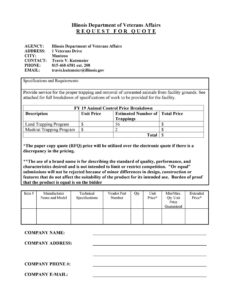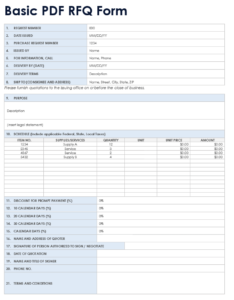Utilizing such a document offers numerous advantages. It saves time and resources by standardizing inquiries, allowing for efficient comparison of vendor capabilities. This structured approach also promotes transparency and reduces the risk of misunderstandings, leading to better-informed decisions and stronger vendor relationships.
This foundation of organized information gathering is essential for successful vendor selection and project execution. The following sections will delve into specific components, best practices, and examples to demonstrate effective implementation.
Key Components
Well-defined sections within the document ensure clarity and completeness. Each component plays a vital role in obtaining necessary information from potential vendors.
1. Introduction/Project Overview: Clearly outlines the purpose of the request and provides background information on the project or initiative.
2. Company Information: Requests relevant details about the vendor, such as company background, size, and experience.
3. Scope of Work: Details the specific services or products required, including functionalities and performance expectations.
4. Requirements: Outlines specific needs, including technical specifications, deliverables, and timelines.
5. Submission Instructions: Provides clear instructions on how vendors should submit their responses, including deadlines and formats.
6. Evaluation Criteria: Explains how responses will be assessed, ensuring transparency and fairness in the selection process.
A comprehensive document incorporating these elements allows for thorough evaluation and informed decision-making in vendor selection. This structured approach promotes efficient communication and facilitates a smooth procurement process.
How to Create a Request for Information Template
Creating a well-structured template facilitates efficient information gathering from potential vendors. A systematic approach ensures clarity and consistency, enabling effective comparison and informed decision-making.
1. Define Objectives: Clearly articulate the goals of the information request. Specifying the information needed helps focus the document and ensures relevant responses.
2. Develop a Standardized Format: A consistent structure ensures ease of comparison across vendor responses. Use clear headings and subheadings to organize information logically.
3. Craft Clear and Concise Questions: Unambiguous questions elicit specific information, reducing the need for follow-up inquiries. Avoid jargon and technical terms that may not be universally understood.
4. Establish Evaluation Criteria: Predetermined criteria enable objective assessment of vendor responses. Clearly defined metrics allow for a fair and transparent selection process.
5. Include Submission Instructions: Providing clear guidelines on response format, submission deadline, and contact information ensures a smooth and efficient process.
6. Review and Refine: Before distribution, thorough review ensures clarity, completeness, and accuracy. Internal feedback can identify areas for improvement.
7. Pilot Test: Testing the template with a small group of vendors can provide valuable feedback and identify potential areas for refinement before widespread distribution.
8. Maintain Version Control: Tracking revisions ensures consistency and facilitates accurate record-keeping. Clear versioning prevents confusion and maintains document integrity.
A well-crafted template, consistently applied, streamlines the vendor selection process, leading to informed decisions and successful project outcomes. These steps ensure the document effectively gathers the necessary information while promoting clarity and efficiency.
Effective utilization of structured information-gathering documents is critical for successful vendor selection and project management. Standardized templates provide a framework for obtaining consistent and comparable information, enabling informed decision-making and fostering transparent communication between organizations and potential suppliers. Key components, including a clear project overview, detailed requirements, and well-defined submission instructions, contribute to a comprehensive understanding of vendor capabilities. A methodical approach to template creation, incorporating objective evaluation criteria and rigorous review processes, further enhances the effectiveness of these tools.
Strategic implementation of these best practices ensures efficient resource allocation, mitigates risks, and ultimately contributes to successful project outcomes. Organizations that prioritize structured information gathering position themselves for greater success in navigating complex procurement landscapes and building strong vendor relationships.

